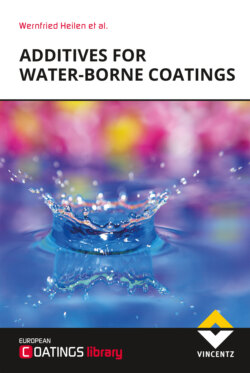Читать книгу Additives for Water-borne Coatings - Wernfried Heilen - Страница 57
На сайте Литреса книга снята с продажи.
3.2.2.2Entry barrier/entry coefficient
ОглавлениеThe entry barrier describes the kinetic resistance which a defoamer droplet must overcome to break through the lamella surface.
The first step of defoaming is always the entry of the defoamer droplet into the surface of the lamella, i.e. the interface to the surrounding air. To do so the defoamer must have a low surface tension [2] [3]. If a defoamer droplet comes into contact with the surface of a lamella as a result of motion in the lamella due, for example, to drainage-induced flow, the droplet needs to overcome the entry barrier to reach the lamella/air interface.
Figure 3.3: a) Distribution of defoamer droplets in a lamella, b) Defoamer droplet enters the lamella
Figure 3.3: b) Distribution of defoamer droplets in a lamella, b) Defoamer droplet enters the lamella
The entry barrier of the lamella surfaces is determined by the surfactants stabilising the foam. Systems with low surfactant content, below the critical micelle concentration have a low entry barrier. The entry barrier rises with increasing concentration of surfactant on the lamella interface to a maximum value at total saturation. Another parameter determining the entry barrier is the mobility of the surfactants. Dynamic processes create new interfaces or subject lamellas to stress due to expansion. To create a stable foam, the newly formed surfaces must be quickly covered with surfactant. In systems with less mobile surfactants, saturation of the newly created interfaces with surfactants is delayed, thus facilitating ingress of the defoamer droplet at these temporarily inadequately stabilised areas in the lamella [8].
Once a defoamer droplet passes the entry barrier and enters the interface of the lamella, the next step is determined by the entry coefficient. The entry coefficient E describes the thermodynamic equilibrium of the oil droplet in the lamella at the liquid/air. interface [4] [5].
E = σ AW + σ OW - σ OA
If the entry coefficient is negative, complete wetting of the defoamer by the liquid phase is the most thermodynamically-stable condition. In this case, the droplet would leave the interface and migrate back into the liquid phase. Only if the entry coefficient is positive will the defoamer droplet remain on the surface of the lamella.
A positive entry coefficient for the defoamer oil is an important prerequisite for many defoaming mechanisms. However, to be effective defoamers also need to fulfil other requirements [8].
